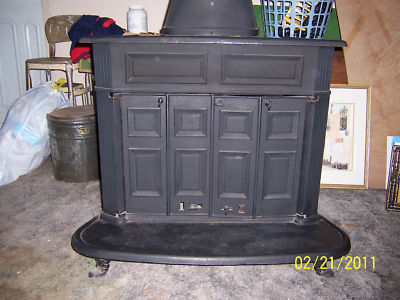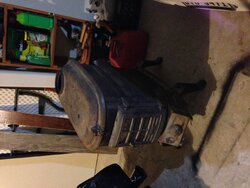Montgomery ward wood stove 74AS7302A
- Thread starter David61
- Start date
-
Active since 1995, Hearth.com is THE place on the internet for free information and advice about wood stoves, pellet stoves and other energy saving equipment.
We strive to provide opinions, articles, discussions and history related to Hearth Products and in a more general sense, energy issues.
We promote the EFFICIENT, RESPONSIBLE, CLEAN and SAFE use of all fuels, whether renewable or fossil.
You are using an out of date browser. It may not display this or other websites correctly.
You should upgrade or use an alternative browser.
You should upgrade or use an alternative browser.
- Status
- Not open for further replies.
Best bet is that it is the US Stove version of a Franklin fireplace stove that Ward sold a bazillion of during the fuel crunch in the mid seventies. I had one. Craigslist is the best source of parts. People sell them there all the time.
No, I'm traveling now for a week with no pictures yet . Single burner, pig shape, top slides to the left. Six windows in the front door, 28 embossed behind the chimney, probably 30 inches tall. I need the screen and plastic sheet for the windows.Does it look like this?

Yeah, I don't know anything about your stove, but helped my cousin restore a different old stove that had the mica windows. He was able to buy some sheets from an eBay vendor and trim them to fit. I've heard of other folks actually retrofitting modern pyroceram into old stoves, but that's much more expensive, as each pane must be custom cut by a commercial supplier, then the stove has to be modified to accommodate them. I'd definitely find some mica if I were doing it. The screens should be easy enough to make from a fine mesh stainless steel hardware cloth. Rick
Thanks for your help Rick. One more please, I'm hearing pig stove when asking the locals. How is a stove size determined? Front to back of the inside of the box or top to bottom of the interior?Yeah, I don't know anything about your stove, but helped my cousin restore a different old stove that had the mica windows. He was able to buy some sheets from an eBay vendor and trim them to fit. I've heard of other folks actually retrofitting modern pyroceram into old stoves, but that's much more expensive, as each pane must be custom cut by a commercial supplier, then the stove has to be modified to accommodate them. I'd definitely find some mica if I were doing it. The screens should be easy enough to make from a fine mesh stainless steel hardware cloth. Rick
Never heard the term "pig stove". The only stove size we typically talk about around here is the interior volume of the firebox, in cubic feet. We frequently discuss exterior dimensions, of course, when it comes to installation details and clearances to combustibles, but as far as the opening of a stove discussion goes, we're talking like, "Oh yeah, that's a 1.4 ft³ stove, right?" or words to that effect. I'd love to see a pic of your stove so I understand what we're talking about. Rick
The only thing that pops into my mind with the term "pig stove" is something like the Vogelzang Boxwood, because of its shape, but I don't think that's what you're talking about.
http://www.northerntool.com/shop/to...i_sku=173896&gclid=CMOelYimmcECFQZrfgodDrYAqg
The only thing that pops into my mind with the term "pig stove" is something like the Vogelzang Boxwood, because of its shape, but I don't think that's what you're talking about.
http://www.northerntool.com/shop/to...i_sku=173896&gclid=CMOelYimmcECFQZrfgodDrYAqg
I haven't heard of a pig stove either, but used to run a pot belly stove with mica in the door. There are pot bellied pigs so... Maybe?
How in the world would you ever clean (sweep) a run of stovepipe like that? And with a stove like this, you're going to want to pay a lot of attention to keeping that pipe clean inside, because it's going to be a dirty burner.. The more heat you think you're trying to retain in the living space is heat you're robbing from the flue gas stream...all this does is cool the gases down to the point where creosote is condensing out all over the inside of the flue. I'd seriously re-think this piping plan. Rick
The bulk of the heat this thing is going to provide is going to be from radiation and natural convection from the appliance itself, not the flue pipe. Straight up through the roof is cheaper, more efficient, and easier to keep clean. The single-wall stove pipe you can run from the flue collar to the ceiling support box will give off some (minimal) additional heat. As soon as you penetrate the structure (either straight up or out and up), you must use Class A chimney components (including whatever you choose for penetrating the ceiling/roof, or wall), which are a good deal more expensive than single-wall stove pipe. Ideally ($$$-wise), you'd route the flue to minimize the Class A requirements, and that almost invariably means straight up is your best bang for the buck. Whatever heat you might think you're gaining by having lots of stovepipe wandering around inside will be more than offset by the cost of a lot of Class A chimney to go up outside the wall and the nightmare of trying to keep that thing clean and safe to operate. Rick
Understood, you know your smoke. Thanks again RIck.The bulk of the heat this thing is going to provide is going to be from radiation and natural convection from the appliance itself, not the flue pipe. Straight up through the roof is cheaper, more efficient, and easier to keep clean. The single-wall stove pipe you can run from the flue collar to the ceiling support box will give off some (minimal) additional heat. As soon as you penetrate the structure (either straight up or out and up), you must use Class A chimney components (including whatever you choose for penetrating the ceiling/roof, or wall), which are a good deal more expensive than single-wall stove pipe. Ideally ($$$-wise), you'd route the flue to minimize the Class A requirements, and that almost invariably means straight up is your best bang for the buck. Whatever heat you might think you're gaining by having lots of stovepipe wandering around inside will be more than offset by the cost of a lot of Class A chimney to go up outside the wall and the nightmare of trying to keep that thing clean and safe to operate. Rick
- Status
- Not open for further replies.
Similar threads
- Replies
- 1
- Views
- 388
- Replies
- 2
- Views
- 165
- Replies
- 6
- Views
- 1K



